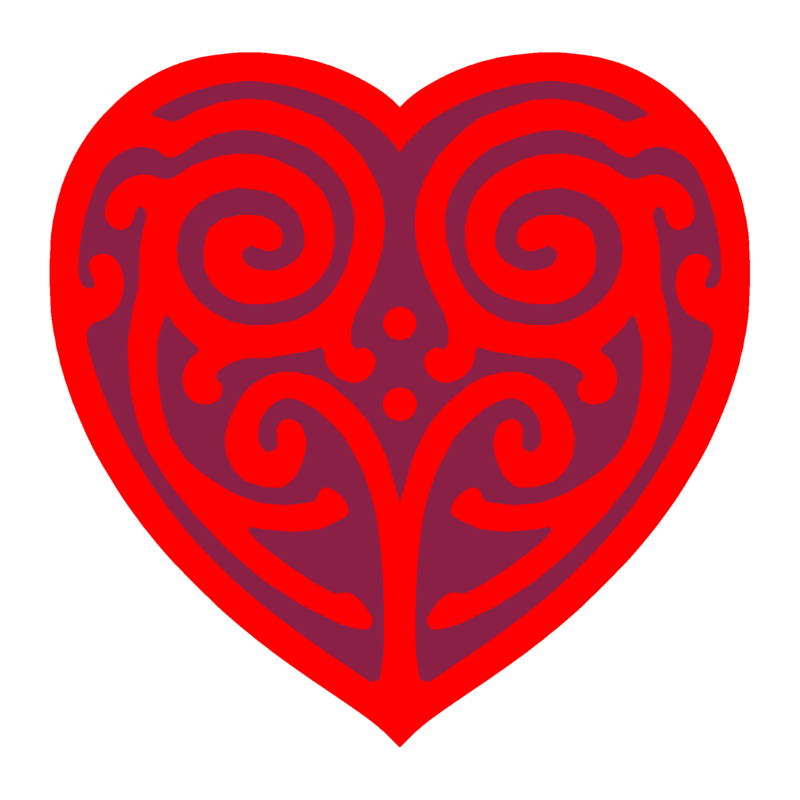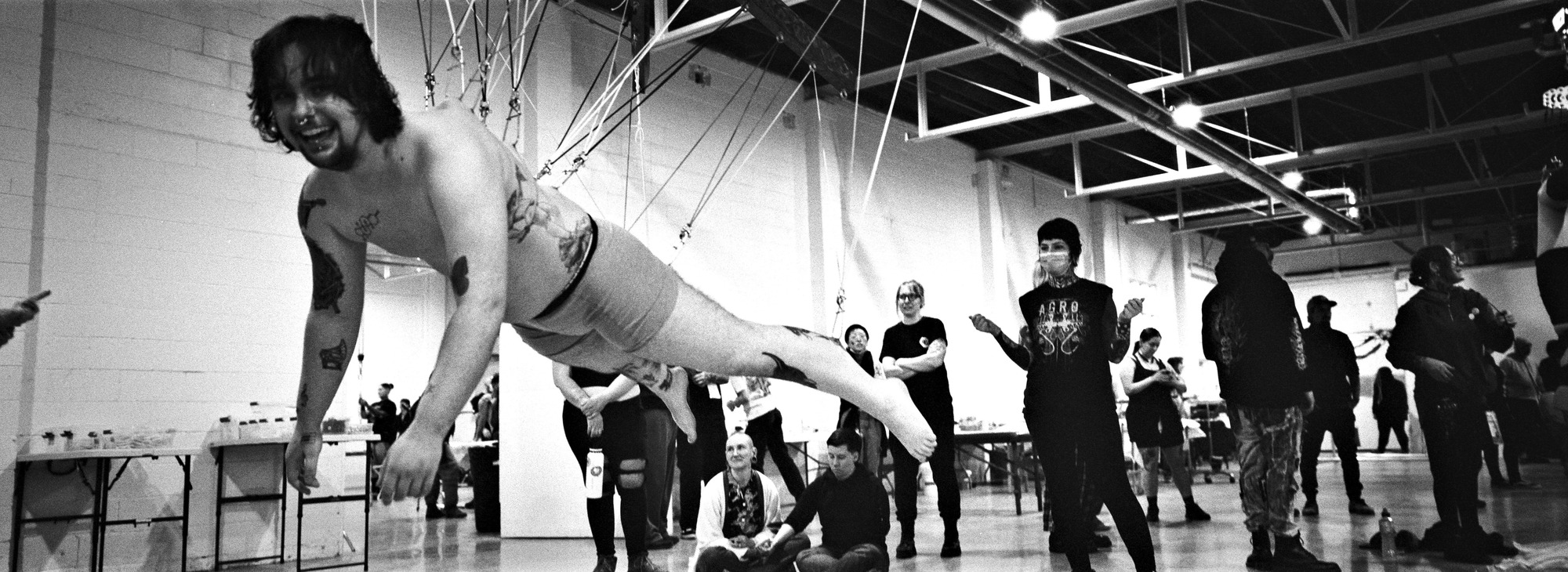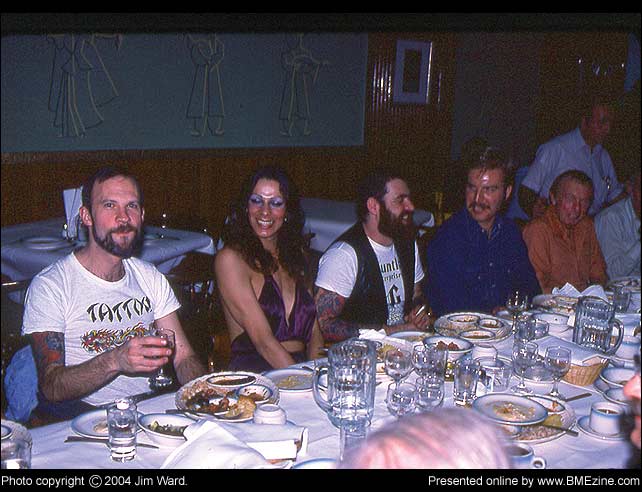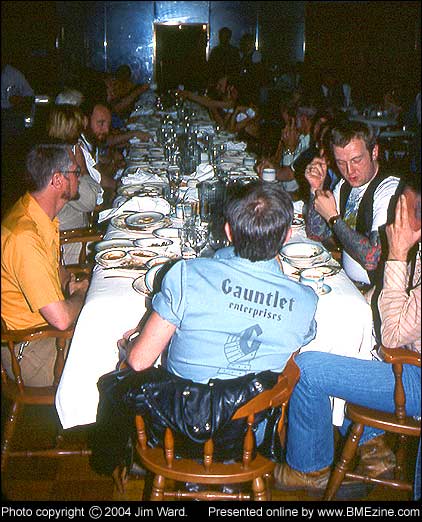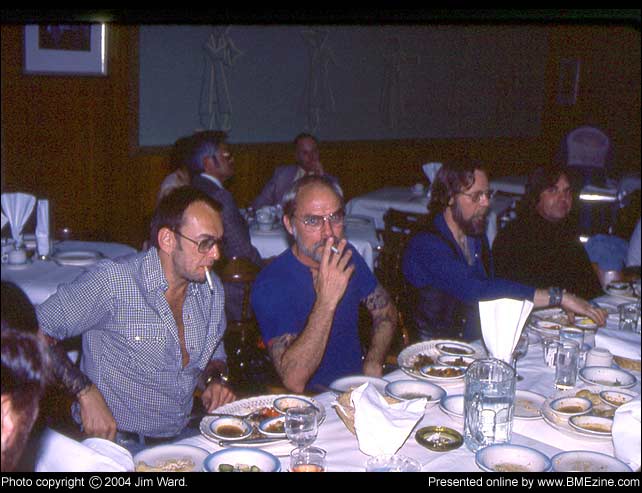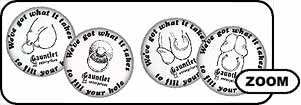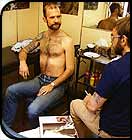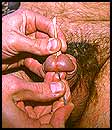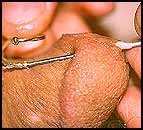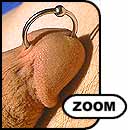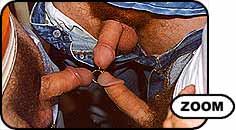 “In the beginning there was Gauntlet” Starting any new business can be challenging especially for someone who’s never done it before. The challenge gets multiplied several times when it’s in a new industry. To the best of my knowledge no one before me had ever attempted to do just body piercing as a profession. A handful of tattooists were doing it, but it was strictly a sideline.It’s not that someone else couldn’t have done what I did. The time just happened to be right, and I was the one who seized the moment. Within a few short years the world had seen the hippie movement, women’s liberation, and gay liberation. The sexual revolution was in full swing. I saw no reason to be ashamed because piercings turned me on and no reason why the rest of the world shouldn’t find out what piercing might have to offer them. I imagine the process of starting a new business is pretty much the same anywhere, but here in California you have to file a fictitious name statement and run a notice in the newspaper to the effect that you’re doing business under that name. Then you need to open a business bank account and do the necessary paperwork with the State Board of Equalization for the privilege of collecting sales tax. Plus there are lots of little odds and ends. It’s pretty much a pain in the ass. But before you can do anything you need a name for your business. Doug and I went back and forth trying to come up with something. He favored a mythological theme such as the name of a Greek god. I wanted something with a tough, masculine feel that would appeal particularly to the gay leathermen and S/M fetishists I perceived as my most likely customer base. In the process of accessorizing my leather wardrobe, I had made a wide leather watchband edged with silver-colored pyramid-shaped studs. While watching television one night I removed my watch and set it on the end table. A short time later I glanced over to see what time it was, and in a flash the name came to me. GAUNTLET! It was everything I wanted the name to be. In addition to being rugged and masculine, it also had metaphoric implications. We have two sayings, “run the gauntlet,” and “throw down the gauntlet,” expressions for the ordeal and the challenge. Didn’t that precisely describe this business venture? I did have momentary second thoughts only because there was already a well-known leather bar in LA called The Gauntlet. But that didn’t seem to be a big problem since I’d be calling my business Gauntlet Enterprises. Doug liked the name as soon as I told him about it. He was, however, of the opinion that I should incorporate. But since he didn’t want to be a stockholder or to have any legal attachments to the business, I opted for a sole proprietorship. It was November, astrologically the time of year Scorpio babies are born. Scorpios are supposed to be highly sexual, so I thought it would be an ideal time for my business to be born. Since the sign ends around the 21st of the month, I needed to act soon. Thus it was that on the 17th of November 1975, I drove to the closest newspaper office, filled out the necessary forms, and filed the fictitious name statement. Gauntlet Enterprises was on its way. There was now a flurry of activity. So many things needed to be seen to: the bank account, sales tax issues, setting up a place to make jewelry, developing jewelry designs, designing a logo… the list went on. Everything seemed to be happening at once. My mental picture of the logo was of a stylized gauntlet forming the letter “G.” It could thus be used alone or combined with the remaining letters of the word. The personal computer was still about a decade in the future. Artists and designers relied for the most part on traditional media to do their work. One of the newer innovations of the time was rub-on letters. Several companies made them, and though the market for them has largely disappeared, you’ll occasionally see them in art supply stores. At one time there were hundreds of fonts available in a variety of type sizes, with perhaps one or two sizes on a sheet. They consisted of a transparent plastic sheet on which an assortment of letters was printed, mirror image, and then coated with a pressure sensitive adhesive. You would place the sheet, sticky side down, on a surface and one by one rub the letters onto it. After spending some time browsing through the catalogs at the art supply store, I found a font that seemed to have the character I was looking for and a letter “G” that had a vaguely open fist shape. The font was called Hondo. I purchased a sheet of larger sized letters. A visit to the public library proved helpful. Browsing through several books with pictures of medieval armor, I found a number of images of gauntlets from which to draw inspiration. Back home I gathered my art materials together and set out to create the logo. After rubbing a capital “G” onto a suitable piece of paper, I took a sheet of tracing paper and a pencil and began to sketch over it, trying various ways of creating a gauntlet from the letter. In time things came together and I had something that looked like it would work. After carefully tracing the design onto the sheet with the rubbed on letter, I used a draftsman’s pen to ink the details. It took several attempts to get things precisely right, but finally, success. To be able to make jewelry I needed a jeweler’s workbench. Commercially made ones were very expensive, and I felt the money could be better spent. Using scrap lumber from construction sites and a piece of plywood from a packing crate, I made my own workbench. It might not have been much to look at, but it was functional and adequate for my needs. That bench was in use till Gauntlet’s demise nearly 25 years later, and by some twist of fate, and the generosity of Josh at Good Art, I still have it today. Here on BME Gauntlet has earned the reputation for being “conservative.” In this forum that is something of a dirty word, usually used with contempt and derision. The same people who are quick to assume that I never took risks often fail to consider what things were like in 1975. Because there was little precedent, everything I did in those days was a risk. No one had ever attempted what I was doing at least on the scale I intended to do it. There was no Internet providing vast informational resources at the tip of one’s fingers. Every piercing technique, every jewelry design, every material used for the jewelry or in the piercing process had to be subjected to a trial and error process. That meant taking risks. Rather than calling me conservative, a better word would be cautious. It was essential to me that every precaution be taken to assure the well being of every person I pierced or who wore my jewelry. What would the fate of the entire piercing movement been if I hadn’t proceeded cautiously and someone had suffered serious harm? How quickly would the movement have come to an abrupt end? Fortunately, starting out with such a small customer base I was able to personally keep tabs on the people I did business with. If something went wrong, I had the opportunity to figure out why and immediately try something different. By proceeding with caution I could progress slowly and minimize the risk of serious harm. Of course, without Doug none of this would have happened. He provided a catalog of “traditional” piercings, along with their often-colorful histories, which leant them credibility and implied that they were all possible. However crude, he had acquired some rudimentary piercing techniques. Over a period of years he also had managed to make contact with about a hundred fellow piercing enthusiasts. Combined these three things provided a foundation on which I could build my infant business. Doug’s motives for setting me up in business were not entirely altruistic. He was married and had four adult children, but his heterosexual life provided no outlet for his piercing fetish or the expression of suppressed gay yearnings. By helping me start a piercing business he was hoping to have the opportunity to fulfill both these needs. Primarily by placing classified ads in various gay and fetish publications, Doug had made contact with a couple of dozen gay men in the LA area who shared his fetish for piercing. As a means of helping get Gauntlet launched, Doug proposed that we start a social group for these men. We would get together once a month for a potluck supper. After eating and socializing anyone who was interested could get pierced with what Doug called “the laying on of hands,” his term for the moral support of the rest of the group. This gave me the opportunity to do piercings under his direction and at the same time bring in a little money from the sale of the jewelry. On occasion we’d all meet at a local restaurant and reconvene at someone’s home afterwards for the piercing event.
Initially Doug proposed calling the group the Society of Saint Sebastian for the saint who was martyred by being shot through with arrows. But that name thankfully never stuck. Instead it ended up just being called the T&P Group, short for tattooing and piercing. Back in my fine art days I’d made some silk screen prints. The skill came in handy for a bit of advertising and promotion. I silk-screened some T-shirts with the Gauntlet name and logo on the front. I also bought a button making device and produced a series of buttons with drawings of various piercings, the Gauntlet logo, and the slogan, “We’ve got what it takes to fill your hole.” We gave these out to the T&P group and to clients who got pierced. Designing and making jewelry for body piercing offered a wide range of challenges. Before Gauntlet most piercing enthusiasts had no choice but to make do with earrings or some makeshift contrivance of twisted wire. Frequently the material was a silver or gold plated mystery metal hardly suitable for the purpose. Earrings were universally too thin. There were some loop style earrings consisting of a fairly thick tube with a thin wire that was intended to go through the piercing. Some hardy individuals managed to work the thicker loop through their piercings, a process that would have been uncomfortable to say the least. There still remained sharp edges which, if the ring rotated, could irritate and cut the tissue. Bent pieces of wire also posed problems. There was virtually no way to provide a closure that would not snag on clothing or on the edges of the piercing itself. From the beginning there was interest in stainless steel as a material for piercing jewelry, primarily because it was perceived as inexpensive and because many men preferred its silver color. Unfortunately I had no knowledge or experience with the material; every piece of jewelry I’d ever made was of gold or silver. Consequently the majority of my early jewelry was made from gold. I did design some pieces of silver, but the portion which went through the piercing was always of gold. Those who insisted on silver colored metal had to settle for white gold. Our knowledge of jewelry materials at the time was quite limited. I had no idea just what effect the unknown components in various gold alloys had on people’s bodies. Even though I was using 14-karat gold, some people still had bad reactions to it. In those cases our only option was to insert monofilament nylon. We had no idea that nickel was a common allergen in alloys. I’m not proud to admit it, but Gauntlet’s first jewelry brochure included a piece of gold plated nickel silver jewelry. Fortunately we quickly realized its incompatibility and discontinued it immediately. The one piece of jewelry that became Gauntlet’s bread and butter was what I called the Bead Ring. It might more accurately have been called a Fixed Bead Ring since the bead that acted as a closure was soldered to one side of the ring’s opening. In recent years the design has largely be supplanted by the Captive Bead Ring in which the bead simply snaps into a gap in the ring. This design is cheaper to manufacture and allows the wearer to choose a vast variety of bead materials. But since my primary focus was always on piercing as a means of sexual enhancement, I always felt the fixed style was a better choice. One never had to worry about losing the bead in the carpet if the activity got a little rough. I can’t claim that the bead ring design was my own. Back when I first pierced my nipples, I had purchased a pair of earrings of that design in a department store. What made them a unique Gauntlet design was the fact that they were scaled in a variety of larger diameters and thicknesses suitable for body wear.
The first barbells I recall came from Germany. Doug had made contact with Tattoo Samy, a tattooist and piercer from Frankfurt. Over the years Samy came to the States a number of times and frequently showed up in LA to visit Doug. On one of his first visits he showed us the barbell studs that he used in some piercings. They were internally threaded, a feature that made so much sense that I immediately set out to recreate them for my own customers. This was a particularly difficult challenge. The biggest problem was how to do the threading. My gold supplier offered 1/16” gold tubing, the equivalent of 14 gauge. This would work as the post, but how could I tap it? I’d also need the right thickness of wire and a suitable die for the male thread. Fortunately, after consulting some technical person, a company that I had purchased jewelry making equipment from was able to provide the tools that I needed. Next I had to find suitable balls for the ends. Initially I used those ear studs that are just a gold ball attached to a post. I cut off the ear post and soldered the ball to the barbell post. This was completely unsatisfactory. First there was an unsightly flange left where the post was attached to the ball. Second, the ball had a tendency to explode when it was heated with a torch. That wasn’t much fun. Lastly, the material was so thin that after it was heated it became so soft it could easily be dented with the thumbnail. This wasn’t something I could sell. What to do? Fortunately fate intervened. On the elevator at the jewelry mart one day I was discussing the problem with a friend. There was another man on the elevator with us who overheard the conversation and gave me the name of a findings company where I’d be able to purchase “no-hole” balls that would meet my needs. The lead proved invaluable, and for many years Gauntlet purchased balls from them for a number of our jewelry designs. Piercing techniques provided their own unique challenge. Thus far I’d followed Doug’s lead, and aside from the occasional fumble, things were progressing fairly well.
As role models for issues of sterility and hygiene we turned primarily to some of the more responsible tattooists of the time, especially Cliff Raven who had recently moved from Chicago and opened a shop in West Hollywood. Autoclaving instruments after each use was a given. But the use of latex gloves didn’t occur until the AIDS epidemic hit nearly 10 years hence. Our rationale at the time was that even dentists weren’t using them and doctors only used them for surgery or for probing in a patient’s private orifices. For some time we continued to use the ear-piercing gun to do nipples. This limited us to using only 16 gauge, pretty thin by today’s standards, but certainly thicker than the earrings everyone was used to. On occasion I encountered nipples that were on the tough side, but with a little extra muscle I always managed to get the piercing point to go through. Then came the day that forever changed this technique. Doug called me up and told me that some guy who’d answered his classified ad wanted his nipples pierced. We arranged a day and time to go to the guy’s apartment where I would do the piercings. Everything was going smoothly until the actual piercing. The point of the ear piercer scarcely penetrated the skin; it wouldn’t go through. I could feel myself sweating partly from embarrassment, partly because I knew the guy was very uncomfortable. With every bit of strength I could muster, I made one final attempt to get the point to do its work. However, instead of going through, it bent. At this point I realized that the ear piercer was not the best tool for piercing nipples since there was no way to tell how tough they were going to be. By now I was soaking wet. Though uncomfortable, the client was bearing up incredibly well and was determined to persevere until he had the piercings. Doing my best to save face and keep the client calm, I quietly reassured him everything would be fine, set the ear piercer aside, and had Doug get me a cork and one of the large hypodermic needles from the piercing kit. The nipple was still in the forceps. I placed the cork on one side and, placing the needle in position on the other, thrust it through the nipple into the cork. Though the going was still a bit rough, the nipple yielded. I now encountered other problems. The forceps couldn’t be completely removed. I was able to open them and free them on the point end of the needle, but the syringe coupling was too large to pass through the remaining opening. I’d just have to work around them. It was also going to be tricky inserting the jewelry because the point of the needle was beveled. Fortunately we were inserting nipple retainers that had a straight post, so they managed to follow through without too much difficulty. At the time I simply attributed all the fumbling and difficulties to my own lack of experience. This was partly true, but the tools themselves were actually a much more significant factor. This was about to be demonstrated most dramatically as I undertook my first Prince Albert piercing.
Doug’s technique for doing this piercing was incredibly difficult. A small dab of topical anesthetic was placed on the end of a cotton swab (one with a wooden stick) and the swab inserted about an inch into the urethra. After waiting about ten minutes for the anesthetic to penetrate, it was time to do the piercing. The piercer would grip the cotton swab, position its tip just beneath the place where the piercing would go, and, with a hypodermic needle of suitable thickness, pierce into the tip of the swab. In order not to puncture the inside of the urethra, the needle and swab needed to be kept securely together until the needle was outside of it. Any piercer who hasn’t done this has no idea just how hard it is. Unless their grip is just right, the tissue can move around and the needle miss its mark. In time I mastered this technique and eventually figured out a better method, but at the time it was like trying to hit a moving target behind a curtain. Somehow I managed to actually do the piercing. It was now time to insert the jewelry, a 14-gauge bead ring. I had to attempt to get a circular object to follow a straight one with a beveled point. This wasn’t working well. Once again I was sweating profusely and beginning to panic. Things were getting bloody. More by shear force than anything else, I managed to get the ring in. Although the piercee was an incredibly good sport about it all, I felt terribly embarrassed. I knew that this method was too crude. Guys who had been around the S/M scene might easily take it in stride, but I couldn’t expect that of others.
It was then that I had one of my “Eureka!” moments. If I simply cut the syringe coupling off the needle, I would then be able to follow it through with the jewelry. In that instant one of the revolutions in piercing technique took place. From then on at least one hurdle in the piercing process had been conquered. Next: Who Was Doug Malloy? — part 1
|
||||||||||||||||
-
“In the beginning there was Gauntlet” [Running The Gauntlet – By Jim Ward]
Written by
-
Ten Years of Pain [The BME Book Review]
Written by


Ten Years of Pain
by Håvve Fjell – Review by Shannon LarrattLOOK INSIDE

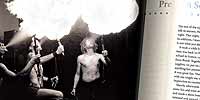


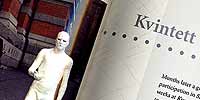
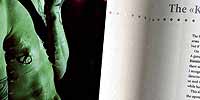



 Being a fakir is not just about showmanship, it is a way of life, a philosophy. You can not learn the discipline if you are not born with the urge to explore the limits of the body.
Being a fakir is not just about showmanship, it is a way of life, a philosophy. You can not learn the discipline if you are not born with the urge to explore the limits of the body.
- Håvve Fjell
This may well be the best body play related book I have ever read (wow!). It is the first book in a long time where I’ve been felt an empathic connection with the content and been drawn deeper and deeper as I progressed. Not since I was a child reading science fiction on winter nights have I been so singularly possessed by a work of prose.
title:
Ten Years of Pain
author:
Håvve Fjell,
photographs by Helene Fjell
author iam:
bleeding
author url:
http://www.painsolution.net/
pages:
180
publisher:
Hertervig Forlag, Norway
rating:
10/10
reviewer:
Shannon Larratt
isbn:
82-92023-12-7
purchase:
BMEshop
summary:
An intimate ten-year history of a modern fakir.
Håvve Fjell is the core of Pain Solution, a Norwegian performance art group — although it has also been a solo project for much of its existence. He exemplifies the modern fakir, both in the sense of performance, fine art, spirituality, and social consciousness. This book, photographed by Håvve’s sister Helene, is an intimate, unflinching, and deeply personal and engaging documentation of his first ten years — as Helene puts it, “Håvve is honest and he has something to say.” The book is written almost entirely in the first person, and its open style makes you feel like you’re reading Håvve’s thoughts.
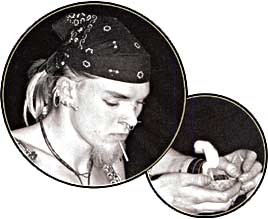
Just over two years ago Håvve was asked to speak about self-harm at a Psykopp-organized lecture for psychiatrists, psychotherapists, and doctors — they were so drawn into the dialog that they approached him about producing a book on the subject. He begins this book by describing his childhood,
Each time I would try to aim a bit higher; cut a bit deeper, burn a bit longer or push more needles into my legs. Of course, no one around me would understand why I did these things to myself, and I could not explain. This led me to do my business in private and try to hide the results from family and friends.
Sound familiar?
In 1991 Håvve traveled to Brazil to develop his skills. In Brazil he met other performers, and did his first fakir show — to an audience who was not expecting or desiring his style of show, and jeered him with taunts of “disgusting”, “sick pervert” and “ugly”.
The rest of the night, I hid. I was too ashamed to see the organizers or talk to anyone. However, two good things came out of that particular night. That night, my girlfriend, Monica, conceived our first son, Kai. In addition, I learned an important lesson about performing in public: it is not what you do, but how you present it that matters.
His confidence returned along with his return to Oslo, where he put on another show with friends (much more successfully) and started thinking about combining the fakir element with performance and stage art. Along with his friends Eirik and Roberto he decided that maybe they could even make a little money if they built a show around fire, juggling, fakirism, and music, and in 1993 PSI (Pain Solution Inc.) was founded.
The first show was a success, but they quickly lost their backing band. The group shuffled members for a while, and Håvve took courses in street theatre, mime, clowning, and acting, and became more and more serious about the professionalism of his show. He returned to Brazil for some time and then back to Norway where he slowly re-tooled his shows for a broader audience — Pain Solution was getting TV gigs, many shows, and media appearances — and also worked with puppet theatre and other art-forms.
We were mostly doing fire stunts and I had padlocks sewn to my torso, this was quite new to me at the time and I was dancing wildly. It came to the point where I felt I was loosing contact with the floor, as if I was dancing without touching the ground. What I felt was pure pleasure. I watched the crowd from above and was about to fly up, and out from the stage. I do not know what really happened, but it was suddenly very quiet. A technical problem with the sound system had put an end to my almost leaving my body experience.
For Y2K Pain Solution was contracted to perform at the largest millennium event in Norway, a huge fire show on New Year’s even in Oslo. After being the pinnacle act in front of 200,000 people Pain Solution started getting larger contracts for custom performances, and Håvve began building a network of actors, contortionists, jugglers, and other performers to work with as shows dictated. Shows got even larger, and in 2001 Pain Solution co-produced Ringen with the Haugesund Theatre, a modern circus group. Large projects always put a lot of stress on a group, and Håvve decided to revert Pain Solution back to being a solo production.
He was then invited to do a series of performances for the Industrial Art Museum in Oslo, and presented them with a plan to do a sculptural or “poetic” suspension. They turned him down, saying that he would scare off their “elderly guests”. Håvve was furious — he’d been promoting the event for three weeks, and his art was being muted.
I saw no reason in arguing, nor did I see any reason to accept being excluded from the programme. I decided to hold a demonstration against censorship, at the museum on that given Saturday. I wrote a new press release explaining the situation. When I sent it out, I made sure they got a copy at the museum.
On the day of the event, I appeared at the Museum with a plaster cast from head to toe, with only holes for my eyes and nose, in a sculpture called Sensurert (Censored). As my assistants carried me out of the van and up the stairs outside the Museum, we were met with hostility; they would not let us set foot on their stairs and stopped us with brute force. Therefore I stood outside on the pavement for nearly two hours, with a supporting crowd, until the cold had made my limbs so numb that I had to give up my demonstration.

The demonstration was a success and the publicity led the House of Artists to contract Håvve to perform Censored, as well as Floating, the project which had been censored. Since it was a six-week installation, Håvve expanded it to Kvintett, five performances of physical restrictions — full body casting, flesh sewing, buried in broken glass, a Chinese-water torture-type event, and a horizontal suspension. The book describes his experiences and encounters in all of these.
However, after this successful series of performances (with a great deal of media and critical attention), Håvve again found himself alone and in debt — for the first time in his life, he had to get a job. Of course, with no education or experience, the best he could do was two part-time jobs — and he feared that a full-time job could interfere with his ability to continue developing Pain Solution. Kvintett had given him a new area to explore as an artist and a fakir — his own personal approaches to pain. His performances became more esoteric, and Håvve became an explorer and researcher as much as an artist.
In the west, our culture brings us up to perceive pain exclusively as a negative experience. No matter how small the injury might be, the most important action taken is to comfort the child. I am not saying that is wrong, but in many cases parents end up teaching their children to fear pain. If a child is bleeding, the hysteria is even worse.
* * * Sometimes the pain is too strong to ignore, it is just impossible not to pay attention to it. In these cases, I try to put all my focus on the pain itself. I search for the centre of the pain. I try to figure out how it spreads, where the borders of the sensation are, and how it feels right next to where it’s hurting. By going into the sensation and exploring it, I find the focus is in studying the pain, instead of suffering it.
…which brings the specific history of Pain Solution up to date.
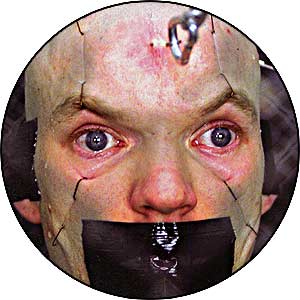
Håvve also communicated with Allen Falkner of TSD in Texas, and after doing a number of suspensions in private and in public (as mentioned above), beginning in 2002 he began co-organizing the annual Wings of Desire – Oslo Body Suspension Festival, an event similar to the SusCons hosted by various suspension groups around the world. He also talks about how hard it’s been for him to achieve spiritual experiences, largely due to the attention he must also pay to the stage aspect.
Addressing something too many amateur performers overlook, Håvve warns about some of the accidents that have happened on stage, including one horrific experience where he breathed in a lungful of paraffin, leading him to ten days hospitalization after the performance. Other shows left him with serious burns, and another with cuts in his hand that resulted in permanent nerve damage. Like many of us, he’s had last minute supply and preparation problems, rigging failures, and other mishaps. “Shit happens and the show must go on!”
The conclusion to the book contains commentary from many of the other members of Pain Solution mentioned in the book, both performers and technical staff. It also contains some interview excerpts and fine arts analysis of Håvve’s performances (“In search of a lost pain” by the Bureau of Contemporary Art Praxis, Rijeka, Croatia, and “Toward the aesthetics of pain” by Stahl Stenslie, Academy of Media Arts, Colgne Germany), commentary from Målfrid J. Frahm Jensen and Per Johan Isdahl (Ullevål University Hospital, Oslo) on the self-harm aspects, and from Siv Ellen Kraft (University of Tromsø, Norway) on the religious aspects. The book then finishes with a short FAQ.
This really is a remarkable book. My review does not do it the justice it deserves. I literally believe it is the only book that has been able to take such a snapshot. I do not believe that any body modification book collection can be called complete without this book, and I believe this is essential reading for anyone involved in performance or body art as well as those interested in art history and body-art/modification/play-history.
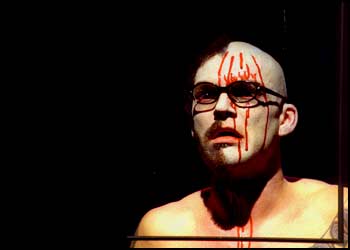
From a technical point of view the printing in this book is gorgeous. It’s large format (10”x10”) and full color with silver spot color throughout its 180 pages and almost every page has photos. The text is clear and easy to read and the photos are bright, crisp, and vibrant (all the pictures in this review are of course from the book). I have nothing bad to say about the book on a conceptual or artistic level, but I do have two complaints in the technical area:
- Binding. Ten Years of Pain is softbound (I made the same mistake with the ModCon book). As a result it damages easily; my copy got banged around a bit in the mail and the corners are dinged — this book is such an obvious collector and display piece that it should have been been printed as a hardcover in my opinion.
- Price. Printing a limited edition book is expensive — as a result, Håvve’s book sells in Norway for 400 Kroners (about $60 US), which, once you add distribution costs, gets up to the $70 US mark by the time it’s made it to North America. That’s a lot to pay for a softcover; if it was any other book I wouldn’t be recommending it so strongly.
I believe that this book will touch you. It might get banged up a little easier than it should, and maybe it costs a little more than is normal, but this book will touch you. For me, it’s worth every cent, and I believe that if you’re a regular BME reader and you appreciate what’s being done here in general, this book will reach you as well.
As far as I know BMEshop is the only place this book is available online. Because I believe in it so strongly I have given up all royalties and commission on its sale in order to ensure the best possible price for you. Please note that we only have a few in stock right now, so if you visit the page and it’s sold out, please be sure to add your name to the “tell me when it’s back” list.

Shannon Larratt
BME.COMPS. Be sure to check out the Pain Solution website at www.painsolution.net!
This page and its contents are © 2004 Shannon Larratt – Reproduced under license by BMEzine.com LLC. All rights reserved. Requests to reprint must be confirmed in writing. For bibliographical purpose this review was published January 21st, 2004 in Toronto, Canada.
-
Rituals of Bodybuilding and Rituals of Body Modification
Written by

“…for the mind is verily restless, O Krishna! It is impetuous, strong and difficult to bend; I deem it as hard to curb as the wind.”
“Without doubt, O mighty-armed, the mind is hard to curb and restless; but it may be curbed by constant practice and by indifference.”
– Arjuna, from the Bhagavad-GitaHowever you look at it, pushing yourself physically is hard work. As human beings, we’d much rather be doing something less stressful and less physically involved. Whether it be body piercing, tattoos, weight lifting or running a marathon, we always approach such activities with trepidation. After all, wouldn’t you rather be at home, reading a book? Or watching a movie? Or drinking with your friends?
I have to admit that I have days where the last thing I want to do is go to the gym, where I destroy my muscle fibers for an hour, and then run my ass off for another 30 minutes. It’s hard to pinpoint exactly why, but “off-days” aren’t uncommon. So I wonder what keeps me going. Why I’m even bothering to sweat buckets under hundreds of pounds of weight every day. Maybe you’ve made an appointment to get your first cartilage piercing, and even though you’ve heard disaster stories, you still get to the shop on time and go through with it. What makes us conquer these fears?
Of course, there is no easy answer. While we’ve all overcome some of our fears regarding activities like piercing, tattooing and scarification, this is where bodybuilding and heavy physical exercise differs greatly. For the most part, the formerly-mentioned activities are isolated incidents, something that we do once (or maybe twice), and thoughts of the eventual outcome gets us through the process. In this case, the few moments of pain (and weeks of aftercare) are worth it, because you’re instantly gratified with a shiny new piece of jewelry, or new colours under your skin. While tattoos can take weeks to heal, they are basically very easy to care for and don’t require much effort on a daily basis — you don’t really need to think about it, other than to keep it clean. Once the piece is finished, you can forget about it.
Bodybuilding, on the other hand, has an influence on your life unlike any other activity I can think of. Assuming you are following a basic four-day (weekly) routine, this means that you’ll be spending about 4 to 8 hours in the gym every week. No, it’s not a lot of time, but realize that it’s getting significantly more time dedicated to it than any other body modification activity I can think of. And all of that work in the gym is for naught if you’re not eating well and getting plenty of rest, both of which can consume your life. Ask anybody who’s started a fitness plan recently, and they’ll tell you that it’s all they can think about — everything you do outside of the gym will affect your performance once inside it. Want to go out drinking four nights a week like you did back in college? Forget about it. No more fast food. No more late nights. You’ll always need access to good-quality food and plenty of water. This is hard work.
Who has put more effort into their body modifications?

Left: Heather Darling with Gregg Valentino (photo: bigheatherd.com), Right: BME’s Shannon Larratt, 1995.
So, again, why do I do it? Why does anybody put their body through something traumatic? Is it for the results? Or is it the journey, rather than the destination?
As a professional body piercer, I’ve heard many of my peers talk about the ritual that surrounds such activities as piercing, scarification and body suspension (though interestingly enough, never about tattooing). While I’m still formulating my own ideas about how my job is considered a ritual act, I can’t deny that ritual does play a part in the piercing process. While many of my clients just want their piercing to be over with as quickly as possible, others are more concerned about being as relaxed as possible, and want me to breathe with them as I perform the act, for example. Whatever makes it easier for them, of course, but this is not specific to the bodily arts.
In the gym, with enough time to observe, I can point out the rituals of everybody there. Some people pace around for a few minutes between exercises, others walk to the water fountain (which is different than bringing your own water bottle), others will repeatedly perform very obviously ritualistic movements to “psych” themselves up before lifting a heavy weight. Again, whatever works — whatever it takes for your mind to make the decision that it can, in fact, lift that weight. And it can, of course, but your mind must be in the ‘right place.’ You’ve all experienced this immediately before a body modification — and it’s a very important part of the ritual for many people.
As an athlete since my childhood, it’s been drilled in my head that sport is “ninety percent motivation, ten percent perspiration,” which means exactly what it sounds like — that most of the work to be done is mental, and the physical will follow. Of course, it’s not that simple — we can’t measure something like this. And if this were the case, then all I’d have to do in the gym to get in shape would be to lift weights for a few minutes, and think really hard for the remainder of the hour. If it were only that easy!
But mental state of mind is the biggest factor to influence our physical actions, whether they be bodybuilding or body modification. Those fitness models and athletes in great shape are truly dedicated to what they do. As I said before, it’s not easy lifting all those weights every day, but something keeps these people coming back for more.
It’s been said that visualization is the key to achieving your goals, no matter what they may be, and this can certainly be applied to exercise. To build muscle, you must tear the muscular tissue. This means lifting weights heavier than you’re comfortable with. So how do you make progress? You’ll only make gains if you’re lifting weights that technically you “can’t” lift — if six repetitions at a certain weight is your maximum, you’re going to have to lift eight repetitions to make any gains. Not easy, and something that lies entirely within your mind’s ability to overcome your physical limitations.
In other words, to take control over your own body.
Sound familiar? I’m sure you’ve heard such a phrase in regards to the type of body modification you’re interested in. Piercing, tattooing or scarification (to name a few) are a major mind-fuck for many people. You go into that body art shop knowing that you’re paying somebody to hurt you. Have you ever thought about what kind of conscious effort that takes? It’s certainly very difficult to overcome what you thought were your limitations. Not to take away from the experience (I still get nervous when I get pierced, even after dozens), but people who are serious about bodybuilding feel very similar sensations every single day. Oftentimes it’s only the thought you know, somewhere in your heart, that you’ll live to see another day that gets you through the workout. Or the piercing. Or the suspension.
So for all of you who’ve been asking what bodybuilding has to do with body modification, this is just one example. Both activities take a conscious mental effort to overcome our physical limitations, exercising the mind as well as the body. We’re not so different, after all.
Camille Paglia once said, “Modern bodybuilding is ritual, religion, sport, art, and science, awash in Western chemistry and mathematics. Defying nature, it surpasses it.”

Dustin Sharrow
PS. I’m very happy to report that my partner is now training three times a week at a mixed martial arts and grappling combat gym. While it is very different from my efforts at getting into shape, she’s loving every minute of it, and subsequently health and fitness have taken on a new importance to both of us, and I couldn’t be happier for her.
-
The Arrest of Todd Bertrang [The Publisher’s Ring]
Written by
 INITIAL NOTE: Please understand that I am unaware of any of the facts surrounding Todd Bertrang’s arrest other than what has been reported in the media. I have not discussed this case with Todd nor am I privy to any knowledge of this alleged crime or any other alleged crimes. I offer this as general commentary only.
INITIAL NOTE: Please understand that I am unaware of any of the facts surrounding Todd Bertrang’s arrest other than what has been reported in the media. I have not discussed this case with Todd nor am I privy to any knowledge of this alleged crime or any other alleged crimes. I offer this as general commentary only.
The Arrest of Todd Bertrang
The more restrictions and prohibitions in the world, the poorer people get.– Lao TzuUPDATE 01/11/04: Authorities have admitted that they have absolutely no evidence that Todd has ever done these procedures on minors, other than his willingness to play along with their ridiculous fabrication (which included paying him a preposterous $8,000 for the imaginary procedure on the imaginary clients).Additionally, they have admitted that this whole thing is based on complaints filed by “a woman who said she believed that Bertrang had performed a circumcision on a 10 or 11 year old girl”. Given how many times I’ve heard people in the BME chat room that he’s rubbed the wrong way conspire to fabricate false charges against him, why am I not surprised? People said they’d get him busted for things he never did, maybe they succeeded (to put this into time context, it played out in the spring/summer of 2002).
As I write this, Todd Bertrang and his parter Robyn sit in prison for allegedly conspiring to perform female circumcisions on minors. The procedure they were offering is encouraged by the medical community, and, with slight (gender) variation, is even legal for non-doctors to perform. Not only that, but there never actually even were any minors — the whole thing was a cleverly concocted fantasy designed to entrap Bertrang. No matter what your opinion of Todd (he’s never masked his sexual overtones), this arrest is troubling on two levels — first, because it involves a deeply hypocritical law, and second, because it involves a questionable sting on a body modification artist.
To be clear let’s put the procedure in question into context: female circumcision. FGM. Female genital mutilation. It sounds terrible, doesn’t it — but it’s a loaded term chosen by activists (male circumcision is known as MGM, or “male genital mutilation”). The procedure we’re talking about isn’t an infibulation or a clitorectomy — it’s a circumcision (“to cut around”). The purpose of the procedure is to reshape the labia into a more pleasing form and to reduce or split the hood in order to make the clitoris more exposed. The procedure is designed to be a positive and enhancing one, not something oppressive or abusive.
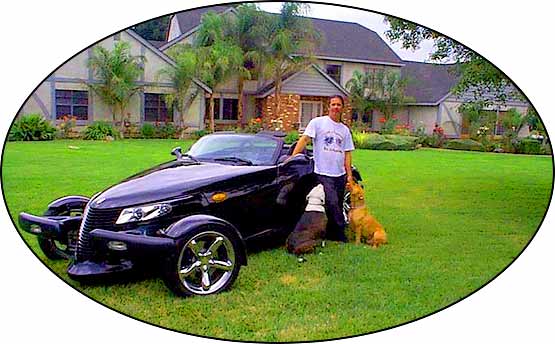
The Hypocrisy
Proponents of female circumcision in the West (it’s a popular elective surgery) will tell you that it enhances the appearance of the genitals, as well as making sex more physically pleasurable. Proponents in Africa and the Middle East will tell you that, on top of its cultural and religious importance, it maintains cleanliness, prevents disease and cancers, keeps a couple together by making the man able to sexually satisfy the woman, and otherwise protects the woman who receives it. Some regions even have circumcision methods designed to make intercourse more physically pleasurable — in countries that it’s done in, it’s the women who have had the procedure that are usually the strongest proponents of continuing the practice.
Now don’t get me wrong — in spite of all these wonderful things about it, I believe it’s fundamentally wrong to force this on a child who can’t decide for themselves, let alone to allow an unqualified practitioner to do it. But we have to take an objective look at this in light of procedures that we do allow.
While most Western countries have phased out the procedure as barbaric, and the AMA has decried it as pointless and dangerous mutilation, in America, the genitals of young boys are still routinely partially amputated. The foreskin, one of the most nerve-heavy parts of the male genitals (and containing glands essential to genital health), is cut off, usually without anesthesia. Significant complications arise annually and numerous men permanently lose sexual function from this procedure. While it is most commonly done by a doctor, non-medical practitioners are also permitted to perform the procedure in private home ceremonies. No health benefits have ever been conclusively shown for this procedure, and the original justification for performing it was to reduce masturbation by “associating pain with the penis”.
So, with boys, we allow non-medical practitioners to cut off part of their genitals for dubious reasons, but with women we don’t. The fact is that we can’t have it both ways. Either make male genital mutilation illegal, or allow it for both genders.
The Sting
Underground cutters tend to be motivated by two factors. First, they usually enjoy doing the procedures they offer. Second, they care about the people they are working on and perceive themselves as helping — by offering a procedure that’s not available in the mainstream, they fulfill an important need and improve someone’s life (and thus they feel a need to come to the aid of someone in distress). The authorities understand that and in their stings play to the desires and ethics of their victim, dangling the perfect carrot in front of their noses.
It’s no secret from his actions in online chat rooms that Todd wants to believe that there are cultures that accept his views on female genital enhancement procedures. Additionally, talking to him it’s clear not only that he’s “getting off” on doing the procedures, but that he cares about his clients. The FBI appears to have presented Todd with a fabricated situation that seemed to good to be true — the opportunity to help a pro-circumcision family (ie. a culture that accepted his belief structure), and to improve two young girls’ lives.
Maybe you’re saying, “Shannon, are you insane? He was a pervert who was hoping to get off cutting up young girl’s genitals!”
That may or may not be true, but the fact is that those girls never actually existed and Todd never sought them out — the FBI presented them to him along with a tailored backstory to make it appear to Todd like he was doing the right thing by allegedly agreeing to perform the operation. Given that it was happening on minors with the full consent of the “parents”, and with the presented goal of helping the minors, can you really say it was even illegal? (Remember, we allow parents to send their children to absolutely brutal, sometimes fatal “Boot Camps”). In Todd’s eyes, and in the eyes of millions of people around the world, this procedure is positive and normal (which would make the government the oppressor, and Todd an agent of freedom). The FBI basically tricked him into allowing his beliefs and ethics to get the better of him.
* * *
I’m not trying to defend Todd with this article — if the allegations are true and he offered to work on minors like this, in my opinion he went too far. However, I do feel that it’s fundamentally wrong to charge someone for a crime that only exists as a police fabrication, and I believe it’s even more wrong to charge someone with laws that are by their very nature racist and sexist. These are unjust laws being applied with a heavy hand. Maybe Todd hit on you in a chat room and you’re glad to see him finally go down — but are you really comfortable having it happen like this?
Most body modification happens in a grey area. It’s usually not entirely legal, but it’s also usually not entirely illegal either, depending on how you look at it. Because of this, it’s very easy for almost any body artist to be arrested at any time, based on the whims of local or federal prosecutors. Body modification procedures are safer than everyday activities like driving a car, occur almost exclusively between consenting adults, and usually involve procedures not being medically offered (making underground the only option). To be clear, the laws are fundamentally unjust. Until we either start banning everything, or these procedures start getting medically offered, it is wrong to deny these grass-roots solutions.
The other reason body artists should be wary is if the FBI is setting up stings that seem “too good to be true”, you never know who could be next or how. Most body artists are pretty honest easy-to-read people — it’s very easy to figure out what makes them tick. We’ve accepted as a culture that it is wrong for our authorities to engage in entrapment (entrapment being when the police fabricate an illegal act, encourage the mark to take part in it, and then charge them for it), yet we’ve just watched Todd Bertrang fall victim to it. Because of the seemingly heinous nature of the charges (mutilating the genitals of young girls), most people don’t even consider the fact that this isn’t justice — just like we’re instinctively ready to act outside or beyond the law when it comes to dealing with child molesters and sex criminals.
So objectively, what we have here is an arrest of questionable legality for a fabricated crime, which is only a crime under laws which are hypocritical at best. Ask yourselves — are you willing to allow it to happen just because you don’t like Todd? Then ask yourselves a second question — will it happen again? What do you believe in that the mainstream may not agree with?

Shannon Larratt
BME.comYou can get in touch with Todd via his website at ToddBertrang.com, although you should be aware that all communication is probably being monitored.
-
Modified Does Not Equal Apathetic [Guest Column]
Written by

Modified ≠ Apathetic “Never doubt that a small group of thoughtful, committed citizens can change the world; indeed it is the only thing that ever has.”
– Margaret Mead(CLICK PHOTOS TO ACCESS IAM PAGE)
 Kyle is an eighteen year old male from Barrie, Ontario, Canada. He currently lives at home with his parents and due to him recently relocating he is unemployed. He co-founded Skate-4-Cancer with his friend Rob Dyer in July 2003. He currently has four piercings (tongue, nipples, and his lobes stretched to 00 gauge). He has three tattoos: words on his stomach, Sailor Jerry flash on his back, and stars on his arms. The co-founder of the Skate-4-Cancer charity has stretched lobes, a nipple piercing, and multiple tattoos including a 3/4 sleeve in progress.
Kyle is an eighteen year old male from Barrie, Ontario, Canada. He currently lives at home with his parents and due to him recently relocating he is unemployed. He co-founded Skate-4-Cancer with his friend Rob Dyer in July 2003. He currently has four piercings (tongue, nipples, and his lobes stretched to 00 gauge). He has three tattoos: words on his stomach, Sailor Jerry flash on his back, and stars on his arms. The co-founder of the Skate-4-Cancer charity has stretched lobes, a nipple piercing, and multiple tattoos including a 3/4 sleeve in progress.
 Liz is a 35 year old female real estate broker who formerly worked in the music business for Capitol and Virgin Records in NYC. She graduated with a BA in Media studies and currently lives in Boston, Massachusetts, USA with her husband. Liz has approximately 60 hours of tattoo work, she has half sleeves, a nostril piercing, and a vertical hood piercing.
Liz is a 35 year old female real estate broker who formerly worked in the music business for Capitol and Virgin Records in NYC. She graduated with a BA in Media studies and currently lives in Boston, Massachusetts, USA with her husband. Liz has approximately 60 hours of tattoo work, she has half sleeves, a nostril piercing, and a vertical hood piercing. Nick is a 45 year old male and living in New York City, New York, USA. He has a degree in Architecture from New York’s Cornell University and is currently a very successful and sought after architect. Considering Nick only started his journey into modification in 2003 he is heavily modified with 52 tattoos including full sleeves, and multiple piercings including a 0 ga Prince Albert, 0 ga labret (recently retired due to gum recession), and 3/4″ stretched lobes — When asked why he got his mods so late in life he replied, “It just felt right, and of course a lot of iam people inspired me! My parents were dead against it, so I waited till they were dead.”
Nick is a 45 year old male and living in New York City, New York, USA. He has a degree in Architecture from New York’s Cornell University and is currently a very successful and sought after architect. Considering Nick only started his journey into modification in 2003 he is heavily modified with 52 tattoos including full sleeves, and multiple piercings including a 0 ga Prince Albert, 0 ga labret (recently retired due to gum recession), and 3/4″ stretched lobes — When asked why he got his mods so late in life he replied, “It just felt right, and of course a lot of iam people inspired me! My parents were dead against it, so I waited till they were dead.”This article is not here (only) to showcase these individuals. It’s here to say, “hey, maybe it’s fun to get involved in my comunity” — and more importantly, that it’ normal to be involved!
Communities tend to react to “aberration” with distrust and ostracism. This ostracism can result in an individual or group being perceived as responsible for the problems in the community, greedy consumption of charitable services they don’t need, behaving in a manner the majority of the community feels is unacceptable, and having an unacceptable appearance.
We in the body modification community have all experienced this ostracism for being “different”. People think we’re violent, mentally ill, unemployed, and addicted to all sorts of illicit drugs simply because of the modifications we’ve made to our bodies and how we dress. Our appearance seems to give those who don’t understand permission to label us with various negative and undeserved attributes.
Historically, while community service and volunteerism has always been a valued trait, actual practice has lagged in recent years, and organizations in need of volunteers often find themselves short-staffed and under-funded as a result. Since his inauguration, American President George W. Bush has issued repeated challenges to the American people to increase the amount of volunteer work being done in the country. Nothing much happened, although the events of 9/11/01 saw volunteerism rates peak for a few months and then slowly decline to the present.
People in the mainstream tend to expect the modified to be among the least likely people to provide any type of community service or volunteer work. However, a surprising number of people involved in body modification feel the motivation to give back to their communities; communities that to a large extent tend to discriminate against them. The people in this article go above and beyond to provide invaluable volunteer services in a variety of areas to the communities in which they live.
They have not only helped their communities but they have gone well beyond the expectations of others by founding a variety of charities and organizations and continuing to work in the non-profit or volunteer sector while maintaining active participation in the modified community. While non-profit work and volunteering isn’t for everyone it does strike a chord with these individuals. At the foundation of all of these people is a willingness and desire to help others through any means possible.
BME: How did you originally get involved with non-profit volunteer work and what was your role in the groups you were with?
Kyle: I never really did much charity work, just the usual stuff they made me do at school: cleaning up roads, picking up litter, and so on. I went down to Toronto once for three days to help feed homeless people and help out at some shelters as well. Up until when Skate
4Cancer was started, I had never really done anything on my own time.
My friend, Rob Dyer, and I started Skate4Cancer together back in July of this year. He originally had the idea about two years ago, and actually tried to start it up but it never took off because he didn’t really have anyone helping him. He mentioned the idea to me during the summer, and I decided I really liked it and offered to help him out by building a website. From there, it just sort of progressed into what it is now.
Skate4Cancer is a charity that was started to raise youth awareness and fund for cancer research. Starting in March of 2004, we will be skateboarding from Los Angeles to Toronto. The entire trip is roughly 5,000 kilometers (3,000 miles) in length.
My role now is maintaining the website, and I continue to help plan what we will be doing and helping out as much as I can at fundraisers and various publicity events. Once we get started on the trip, I will principally be the bus driver and webmaster of the site.
Liz: In 1999 I co-founded a group called Fanseverywhere as a result of the rapes and sexual assaults that happened at Woodstock ’99. I still, to this day, answer email from young girls and women who have been sexually molested and raped at rock concerts.
“I was so offended by what was happening to the women at Woodstock ’99.”The police weren’t any help and women (some as young as thirteen) were being assaulted while crowd surfing or sleeping in their tents. It was outrageous and these women needed somewhere to go to, someone to speak with. I was the Co-Founder and main contact for these women. I conducted letter writing campaigns to NOW and RAINN to alert them of the issues and to record labels and concert promoters urging them to be aware of what was going on at many shows.
Nick: I serve as a Board Member on the NYC City council, for community Board 9, I serve on the Landmarks committee for Manhattan, NYC District 9. I am completing my Police Officer Training, and will serve in the NYPD auxiliary program, walking a beat as a cop in Manhattan.
“I wanted to give to my community.” BME: Have you been involved in other non-profit work other than what you described above?
Kyle: Honestly, I have never done anything like this before. I mean, I’ve given to food drives and donated some money before, but nothing really significant to a non-profit organization.
Liz: I started working with the Milarepa Group to help the Tibetans in 1996 working at the Tibetan Freedom Concerts in SanFrancisco, NYC and Washington DC. I moved on to help an agency called the Tibetan Refugee Health Care Project. I was motivated by my desire to help people in need. I know that I am lucky to have the things that I have and some aren’t so fortunate. I felt compelled to help out where I could.
I volunteered my time with the Milarepa Group from 1996-1998 and assisted with the development of the Tibetan Freedom Concerts. I worked with the Tibetan Refugee Health Care Project from 1998-2000.
The Tibetan Refugee Health Care Project is a non-political organization funded entirely by private donations. It was created in response to the dire and growing need for public health care for the Tibetan community-in-exile, living both in resettlement camps in India, and throughout the world, and to be a support for The Tibetan Government-in-exile, His Holiness The Dalai Lama and the Tibetan Department of Health. All projects are reported to them.
Its mission is to facilitate medical treatment of the Tibetan people as well as to educate them about disease prevention. One of the goals of the project is to encourage Tibetans to learn skills that enable them to help other Tibetans. This is done by training qualified Tibetans so that they may become practitioners, skilled laborers, or volunteers who go back to work in their communities. I volunteered my time to help with anything that needed to be done. I sat in protest of the Chinese government. I ran sound and lights for speeches. I coordinated email campaigns. Helped in the offices. Passed out flyers. For Milarepa, I donated my time to help coordinate other volunteers for the Tibetan Freedom Concerts. This came out to about fifteen hours a week.
BME: What originally prompted you to choose the groups you ultimately worked with?
Kyle: I chose to become involved with Skate4Cancer because I felt it was a worthy cause, and I believe that we can make a difference in the world. I decided early in my life that I would not just be one of those people who graduate high school, maybe go to college and then work a desk job for the rest of their lives. I feel that this might be something I could do for the rest of my life, and this will allow to wake up every morning believing that I have a purpose in my life and I ’m making a difference in other peoples lives.
Liz: Passion. Passion to try to make things better for someone other than yourself. Bring issues to the public eye.
Nick: My architectural background enable me to help the landmarks committee, and the community board, I really wanted to prove to myself that I could become a cop, and am just about complete with my training.
BME: Have you ever had any memorable reactions to your modifications during your volunteer work?
Kyle: Besides the, “Oh, cool tattoos!” comments that are fairly usual, I personally haven’t, but I know Rob (the co-founder of Skate4Cancer) has. I know he’s experienced some negative reactions to his tattoos and even the way he dresses.
Liz: Never anything negative. I would say it has been pretty neutral territory as far as my charity work has been concerned.
Nick: Well, the NYPD did ask me to remove a lot of the metal, but I was more than willing to do that! For my police training I keep the tatts generally covered as much as possible.
BME: Have you found that your modifications have helped or hindered you in this work?
Kyle: I think that they help more than they hinder, because we’ve found what’s key to making Skate4Cancer work is getting the kids to notice it, and then they tell their parents about it. Tattoos are noticed alot of the youth of today because they are ‘in’, most of the youth think they are cool, so they may notice us for our mods, then hear about what we are doing and really like the idea, then helping us spread the word. But on the other side, they have hindered us at times because for the most part, the older generation isn’t too keen on body modification, and thus they don’t think we are serious about it, making them reluctant to donate or preach to others about us.
Liz: Definitely helped for Fanseverywhere. The girls would see the tattoos and would feel comfortable because I was “one of them”
Nick: Neither really. I like trying to break though peoples perceptions of what a tattooed person should or shouldn’t do. But actually no, no problems at all. Everyone remembers me, and that might not be bad!
BME: Why do you donate your time, energy, and resources? What is the primary reason?
Kyle: The main reason I do this is to help myself feel good. As I mentioned before, I want to make a difference to people in my life, and I think this could be something that really changes people and makes them examine themselves.
Secondary to that, I believe that cancer is an epidemic that has to be stopped. SARS was made into such a big deal by the media, but it wasn’t as bad as they made it seem. I don’t want to make it seem like I’m belittling SARS, but on average 185 Canadians die of cancer each day. That’s just in Canada, just think of how many die worldwide. I don’t think many people realize how bad cancer really is.
Liz: I am fortunate in my life, and sometimes someone just has to show you the way up and out of a bad situation. I hope that I have offered that kind of assistance to just one person. Life is what you make of it.
Nick: I love to help others!
BME: What is one thing that stands out that you have learned from your volunteer work that has helped you in other aspects of your life?
Kyle: I’ve learned that no matter how bad my life seems, there is always someone who is worse off then me. I shouldn’t complain about the little things that don’t matter, when my little things are a life-or-death matter to someone else.
Liz: Compassion to others. You never know when your situation is going to become bad and you will need the help of kind strangers. Everyone deserves a chance.
Nick: That I’m a really fortunate guy!
BME: If you could create your own charitable organization what would it be?
Kyle: I haven’t thought about creating other charities at this point, one is enough work right now! but we have a couple ideas on how to expand Skate4Cancer after this initial run, and that should keep me and everyone else busy enough for a little while at least haha.
Liz: To provide inner city school children with all the resources they need to learn music and art. Those programs are being taken away and need to be given back to those who could benefit from them the most.
Nick: I would like to create a foundation to help people to decide to do the right thing, so they can have productive lives.
The people we’ve talked to above are only a brief mentioning of the many volunteers we know that are also BME members. It seems despite the undeservedly grim and often outright bigoted opinions in many articles published in the mainstream media it seems that the modified are doing more than just volunteering in their communities; they are starting organizations to help others, extending their own resources to give others a chance.
They are most definitely not apathetic or “not playing the game of life” as has been suggested, but are instead giving back in ways the “average person” seems either unwilling or unable to do. The communities to which these individuals belong would do well to respect, admire, recognize and aspire to the shining example these people represent not only to their communities, not only to the modified, but to humanity in general.
[Ed note: This is an abridged version of this column; click here for the “director’s cut”]
Danielle (iam: Vanilla) and Chris (iam:serpents) Clark
Copyright © 2004 BMEzine.com LLC. Permission is granted to reprint this article in its entirety as long as credit is retained and usage is non-commercial. Requests to publish edited or shortened versions must be confirmed in writing. For bibliographical purposes this article was first published January 9th, 2004 by BMEzine.com LLC in Toronto, Ontario, Canada.
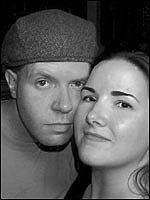
-
Pierced? Get out of America! [The Publisher’s Ring]
Written by

Pierced? Get out of America!
“The more restrictions and prohibitions in the world, the poorer people get.”– Lao TzuIn her opinion piece “How to win at the game that is America” (LINK), Erin Simovic writes that those with piercings and tattoos are “simply not in their right minds”, make no contributions to society, “look like circus members from the underworld”, and are losers who are not fit to be a part of America. This is far from the first moronic article that Ms. Erin “whatever happened to good old-fashioned courting” Simovic has written, but it shines of hatred trying to hide behind a banal smile, her apparent hallmark as a journalist.
She begins, as Rommel did before her, by insulting her subjects, but somehow trying to justify it with an “honest, I’m cool” footnote, which instead serves simply to illustrate how lacking her understanding is.
“Spiky, multicolored hair, chains, studs, piercings, face paint, you name it. It’s the scarifying of America, powered by celebrities like Marilyn Manson. Okay, I know what you’re thinking — sheltered little suburban girl totally out of touch with reality — but you couldn’t be more wrong. I’m hip. I read the Sears catalog. I’m so totally in touch with the kids of today.”
Leveling out at a simpleton’s “gross, I hate you”, Simovic never manages to do anything but string together a series of shallowly hidden insults —
“...those strange city-dwellers who feel compelled to express themselves with bizarre fashion choices. I am being polite, mind you. I would have used ‘freakish,’ but I figured that wouldn’t be politically correct.”
That’s like me saying, “Erin Simovic has poor comprehension skills that are further masked by her xenophobia. I would have said that Erin Simovic was a stupid hateful bitch and it’s people like her who make ‘white’ an insult, but that would be rude.” The underlying point is clear, is it not? Just because you’re smiling when you insult someone doesn’t mean the insult wasn’t real.

Erin Simovic, Oregon State’s own Betty Bowers.Photo: The Barometer
She goes on to clarify that she doesn’t get it with whiney remarks like “why would anyone in his right mind choose to alienate themselves”, and then punctuates them with further insults. She bitterly writes, “these individuals either want to rebel from society or are simply not in their right minds — I tend to lean toward the latter myself.”
She continues, and after a jab about how no one looking like this would ever be a “Miss America contestant”, demands that people with piercings and tattoos make “real efforts to change what they don’t like about society” instead of making buffoons of themselves by wearing “a studded dog collar”. Perhaps she has never been to a protest, or a meeting of environmental activists, and noted the sheer bulk of piercings and tattoos in attendance? If anything, statistically those with body modifications and “nonconforming fashions” are far more likely to be socially progressive and politically active. After a bit more whining and belittling of others she comes right out and says that she believes that the goal of those with piercings and tattoos is to “destroy society”, an opinion so ludicrously removed from reality that one has to start seriously questioning Ms. Simovic’s lucidity.
She goes on to say that those with piercings, tattoos, and unusual fashions aren’t “playing the game”. As a conclusion, she decides that America isn’t ideal for the modified, and that America “will never be for you” if you have piercings and tattoos — a bold statement, given that many would hold that America embraces freedom of expression, and that the wonderful thing about America is that you can do whatever you want as long as it’s not hurting anyone else. (In theory anyway).
I’m not so deluded that I think people should have to like body modification, or that people should be punished if they make hateful bigoted statements like Ms. Simovic does. But I do think that we need to ask ourselves exactly what’s going on when a newspaper publishes articles which serve one goal alone — the dissemination of hatred. This column isn’t “funny” or “witty”. It isn’t “insightful” or even “social commentary” on any level. It’s just an excuse for Ms. Simovic to broadcast her bigotry, and it’s very sad that Oregon State’s Barometer feels this is how it wants to represent itself and the students of Oregon State. I realize that ultimately it is an “opinion” piece, and she certainly has the right to her opinion, but as a journalist she also has a greater duty to a balanced truth.
Let me make it simple: If you don’t like piercings, don’t get piercings and don’t hang out with pierced people. If you don’t like Muslims (I’ll refrain from theorizing as to Ms. Simovic’s feelings about those of color), don’t adopt Islam as your personal faith and don’t hang out with Muslims. But don’t think that your dislike and personal hatreds, coupled with free speech, makes it somehow “ok” for you to broadcast what a horrible person you are, and try and have others adopt your hatreds as well. It might be legal, but it’s definitely not ethical. America — and the modern world in general — is about a myriad of different people getting along and integrating. It’s not about the destruction of other people’s ideas and the eventual creation of a homogenous culture, and it’s not about one esthetic betting superior to another — it’s about a rainbow of different ideas getting along in a rich human fabric.
It’s very sad that Erin Simovic would choose to supplant that with her own boring, bitter, and repressive worldview, and even sadder that a newspaper would see fit to help her broadcast those attacks.

Shannon Larratt
BME.comThe article in question, “How to win at the game that is America” can be found online at http://barometer.orst.edu/vnews/display.v/ART/2004/01/06/3ffae8b99ea61 and Simovic may be reached by email at [email protected]tudentmedia.orst.edu.
UPDATE:
After seeing the feedback her article generated, Ms. Simovic posted,
After reading all this feedback, I am very sorry for what I wrote, I will look at tattooed and pierced people with more respect from now on and not base their characteristics on what decorations they choose to put on themselves.To be honest, I actually find tattooed guys nicer than non tattooed guys because they are able to express their feelings easier, and also they are better in bed. I would know because I am one of those 'been around the block' chicks 😉
Many readers continued to decry her article, not taking her apology as particularly serious. Katie replied,
You once again generalize by saying that you find tattooed guys to be nicer, able to express their feelings better, and "better in bed." Then you go on to boast about your "promiscuous" lifestyle... maybe you don't approve of my ten piercings, but don't expect me to applaud you for being a whore.
-
Tyler Fyre Interview – Through the Modified Looking Glass
Written by

Tyler Fyre Interview
Some say the world will end in fire;
Some say in ice.
From what I've tasted of desireI hold with those who favor fire.
– Robert Frost
-
Top Contributors, 2003 [The Publisher’s Ring]
Written by

Top Contributors, 2003
“A hundred times every day I remind myself that my inner and
outer life depend on the labors of other men, living and dead, and that I
must exert myself in order to give in the same measure as I have received
and am still receiving.”– Albert Einstein
One of the many prizes, a limited-edition custom BME belt buckle.
Not that I don’t work damn long hours, but BME is first and formost a
group — community — effort. BME exists because of the drive
of thousands upon thousands of people of all ages and demographics around
the world believing in its value, and wanting to help bring that to
others. Because of that, at the end of every year I like to do this
little awards ceremony to thank those that went out of their way to
“help in bulk”. It is these people who built BME in 2003 (and some in
2002 also).The competition was a lot harder this year, with BME’s submissions
running at approximately double last year’s speed. Instead of just
doing a top-50 rundown, this year I also split the awards into sections
to recognize the contributions by category. Click any of the pictures
below to check out the winners (and their “acceptance speeches” in some
cases too):
Experience Authors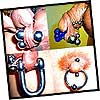
Body Piercing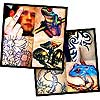
Tattoos
Ritual and Culture
Scarification
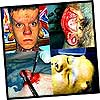
BME/extreme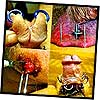
BME/HARD
Top-50, Images
BME StaffThe prizes included custom limited edition belt buckles (which you can see
above if you have Java turned on), and a series of rather odd limited
edition shirts (and more):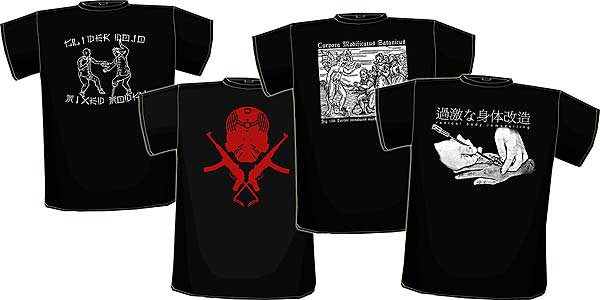
What?!? You want to see them in detail?
You’ll have to wait until the winners
send in photos for the t-shirt gallery!
Again, thank you so much to all of you that helped, and especially those of
you who made it to these top-lists. I really couldn’t do it without you, and
I look forward to working with you more in 2004 and onward. The 21st century
belongs to the individual!
Shannon Larratt
BMEzine.com
-
AMPUTEE ART – The BME Cultural Corner
Written by

Amputee Art
Our masters (the spirits) keep a zealous watch over us, and woe betide us afterwards if we do not satisfy them! We cannot quit it; we cannot cease to practise shamanic rites.– Shaman quoted by Wenceslas Sieroshevksi, 1896Welcome to the BME Cultural Corner.My name is Blake of The Nomad Precision Body Adornment and Tribal Art Museum. This new section of BME/News will focus exclusively on the historical and cultural aspects of bodymod in a traditional context. Personal narratives, stories, articles, rare photos, and new scientific discoveries relating to the endless human need to alter the body will be found here.
In introduction, I am a piercer of fifteen years, museum curator, and self-educated anthropologist. I have also authored a new book (A Brief History of the Evolution of Body Adornment in Western Culture) which is available here on BME. My interests are purely traditional culture — one might call me a conservative democrat, as far as bodymod goes.

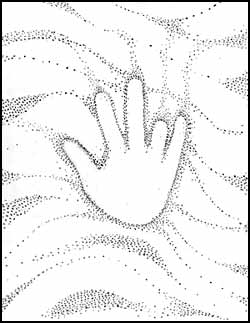
The subject of this first article of the Cultural Corner will be amputation — a subject, I admit, I never thought I would be writing about in a historic context. Only lately associated with the bodymod community, and profiled in a recent one-hour Discovery Channel special as well as Shannon’s book Modcon, deliberate amputation is generally misunderstood. It can be said that amputation is not ornamentation (unless you wear a severed digit in your earlobe), more exactly, it is augmentation.
Randomly ask any amputee today about the nature of their “disfigurement” (ignoring all of the social idiums on couth), and expect one of several primary answers — assuming you haven’t pissed them off or trodden on some painful part of their life better left alone.
Our first hypothetical example: A legless man in a wheelchair — mid 50’s — perhaps he lost them on a mine in Vietnam, his “mobility and vitality” stolen from him in his youth by the “enemy”… non-consentually.
Next, an older man (yes, women can be amputees too) missing a forearm and a hand… his whole life haunted by the feeling that with both hands he is incomplete as a person until that appendage is sacrificed. Consumed with a deep, unnameable need to remove part of the anatomy considered essential — perhaps an “accident” with a Skilsaw — and now he is content… an indescribable inner part of himself somehow satiated.
For our third example we turn back the hands of time (no pun intended)… about 30,000 years! The place is a dark cave in Paleolithic Europe. With the entire clan in attendance — spellbound — an elder shaman severs a digit from his hand. Does he hate himself? No. Does he have issues? No. The primitive mind and developing psyche of humanity is consumed wih offerings of magic, sacrifice, the spirit-world, and the animal kingdom, upon which he depends for survival.
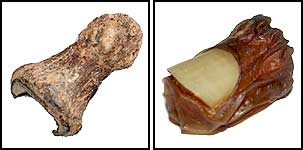
Amputated finger tips. Left: 30,000 years old (© Pawel Valde-Nowak), right: 6 years old (from BME’s collection).What is transpiring in the cave is one of earliest known forms of “religious rite” or spiritual practice and enactment of ritual. In fact, discoveries at Oblazowa, a Paleolithic site in Poland have sparked a huge controversy in the world of prehistoric art. Known to science, yet rare, are hand-stencils on the walls of Paleolithic European caves with missing digits. This “Amputee Art” was previously regarded as examples of illness, accidents or a strange system of communication — until now.
New evidence has unearthed (in the same caves that housed the amputee art): a thumb phalanx, and other human finger bones found in association with shell pendants, stone beads, the perforated teeth of an Arctic fox, a Mammoth tusk boomerang (the oldest boomerang ever found), and other ritual objects. They date to more than 30,000 years ago.
Pawel Valde-Nowak, the scientist who excavated the site believes that this proves that “fingers were amputated in a ceremonial context” and that amputee art gives “depictions of hands (with missing digits) a very particular symbolic meaning”.
Even with our imaginary time-travel, early language, grammar, and syntax prevent the modern mind (if we could ask) from communication with the shaman in the cave. “Why?” we might inquire, yet the ritual context of this ancient amputation lets the scientific mind extrapolate, respect, and appreciate the ceremonial, even religious rite associated with the ancient amputation.

Amputations. Left to right: Performance artist Roger Kaufman who has changed the length of nearly all his fingers and toes (photo: Efrain Gonzalez), healed amputation with original finger tip (photo and model: Jerome Abramovitch), and an “amputation party” in Russia (both photos: BME archives).With scientific evidence substantiating this new theory, further conjecture will be limited only by lack of further archaeological evidence… in the art world, the controversy will likely continue for decades to come. Now science has established ritual amputation to the earliest days of modern man and dated the practice to Paleolithic times, paralleling the emergence of humanity’s oldest forms of ritualized ornamentation and adornment; piercing and tattooing.
Amputation, drugs, religion, meditation or ritualized body adornment are means by which we may glimpse the divine, or, that which is greater than the sum of our “parts”. These vehicles of transcendental experience are doorways to an ancient state of mind. To borrow a quote from my book, “the ways by which we find release and transcendence as a species are varied, indeed.”

Blake
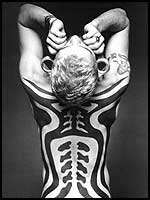
Blake Perlingieri is a body piercer of fifteen years, a museum curator, and a self-educated anthropologist. He is the author of A Brief History of the Evolution of Body Adornment in Western Culture and can be found online (and offline) at nomadmuseum.com.
Copyright © 2003 BMEzine.com LLC. Requests to republish must be confirmed in writing. For bibliographical purposes this article was first published December 17th, 2003 by BMEzine.com LLC in Tweed, Ontario, Canada.
-
SO YOU WANT TO BE A FREAK – Through the Modified Looking Glass
Written by

So you want to be a
FREAK
You wanna have big fame, let me explain
What happens to these stars and their big brains
First they get played like all damn dayLong as you sell everything will be ok
Then you get dissed by the media and fans
Things never stay the same way they began– Cypress Hill, Rap Superstar
